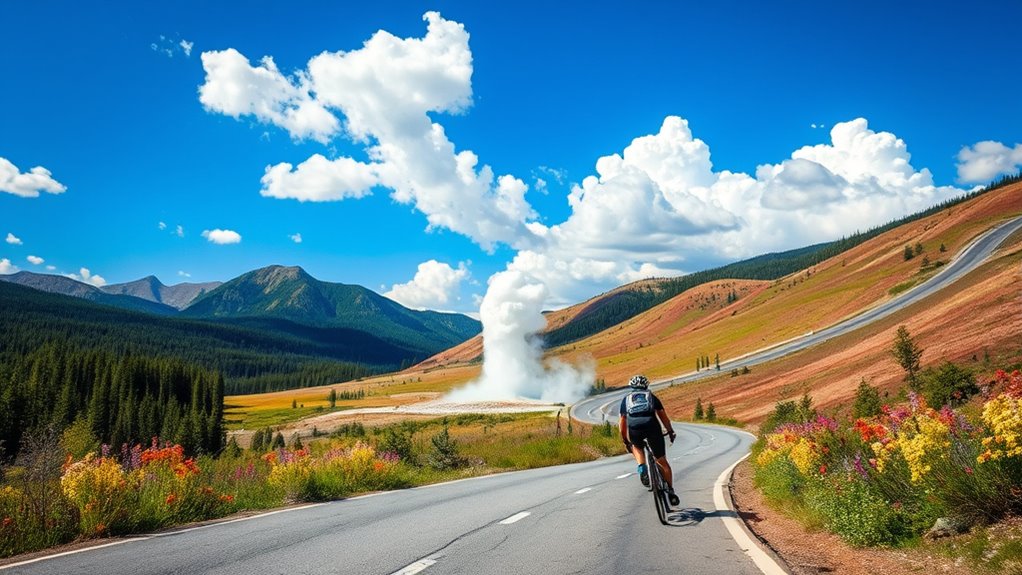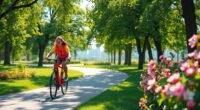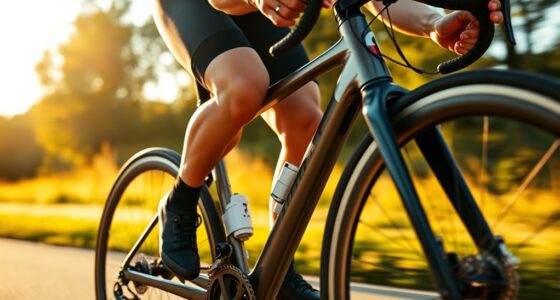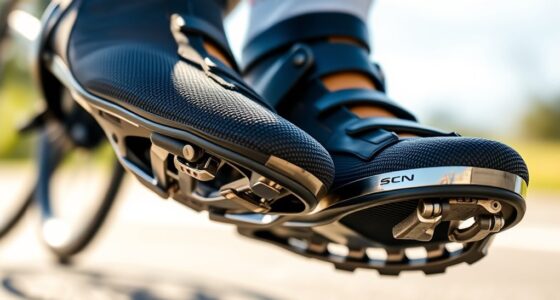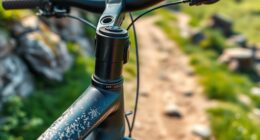If you’re looking to ride Wyoming’s Yellowstone roads, you’re in for an unforgettable experience! Rent hybrid bikes at Old Faithful Snow Lodge and enjoy scenic routes that take you past iconic geysers. Just remember, there’s a $20 entrance fee for adults, while kids under 15 can enter for free. Stay alert for wildlife and be prepared for varying road conditions. Adventure awaits, and if you stick around, you’ll discover more tips for making the most of your biking journey!
Key Takeaways
- Rent a hybrid bike at Old Faithful Snow Lodge for easy access to scenic routes and geysers.
- Explore the 2-mile round-trip from Old Faithful to Morning Glory Pool for stunning views.
- Enjoy a scenic challenge on the 3.5-mile dirt road to Lone Star Geyser.
- Prepare for wildlife encounters; carry bear spray and wear bright clothing for visibility.
- Be aware of unpredictable spring weather and ride single file on narrow roads.
Exploring Bike Rentals at Old Faithful Snow Lodge

When you visit Yellowstone National Park, exploring the breathtaking landscape on two wheels is a fantastic option, especially with bike rentals available at Old Faithful Snow Lodge.
You can rent hybrid bikes perfect for both paved and unpaved roads, ensuring a smooth ride through the park. Rentals also include essential safety gear like helmets, gloves, and jackets.
For families, child bikes and bike trains allow younger riders to enjoy the adventure too. Rates are reasonable, with options starting at just $15 for an hour.
Rentals are typically available from Memorial Day through Labor Day, with some flexibility depending on the weather.
Understanding Entrance Fees and Costs for Cyclists
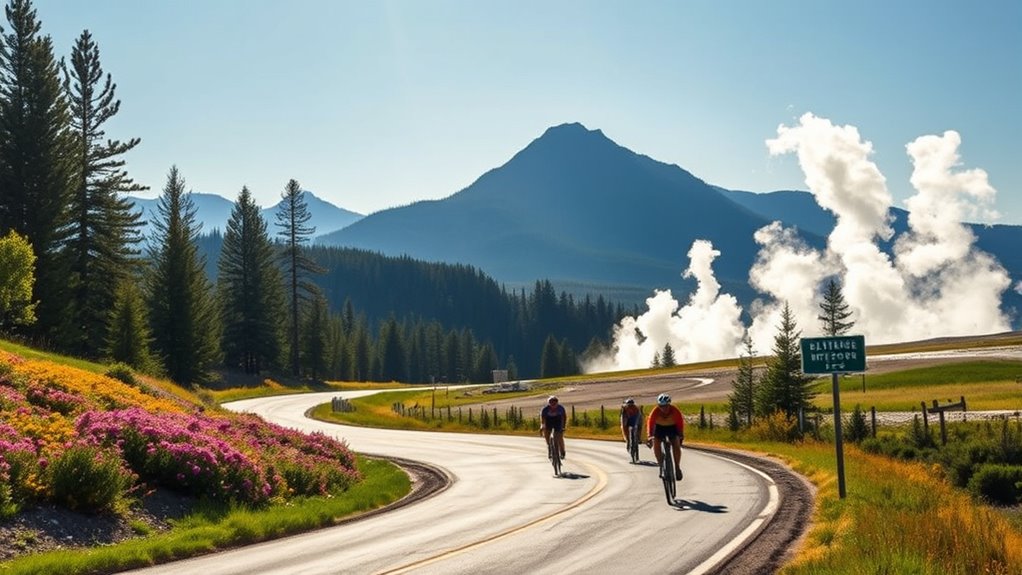
Understanding the costs associated with cycling in Yellowstone National Park is crucial for a seamless visit.
Cyclists pay a $20 entrance fee per person, valid for seven days, which you can conveniently purchase digitally through Recreation.gov. If you’re under 15, you won’t need to pay any fees.
For frequent visitors, consider the Yellowstone Annual Pass for $70 or the Interagency Annual Pass for $80, both valid for a year. Group discounts apply for non-commercial groups of 16 or more, reducing the fee to $12 per person.
Navigating Road Conditions for Cyclists in Yellowstone
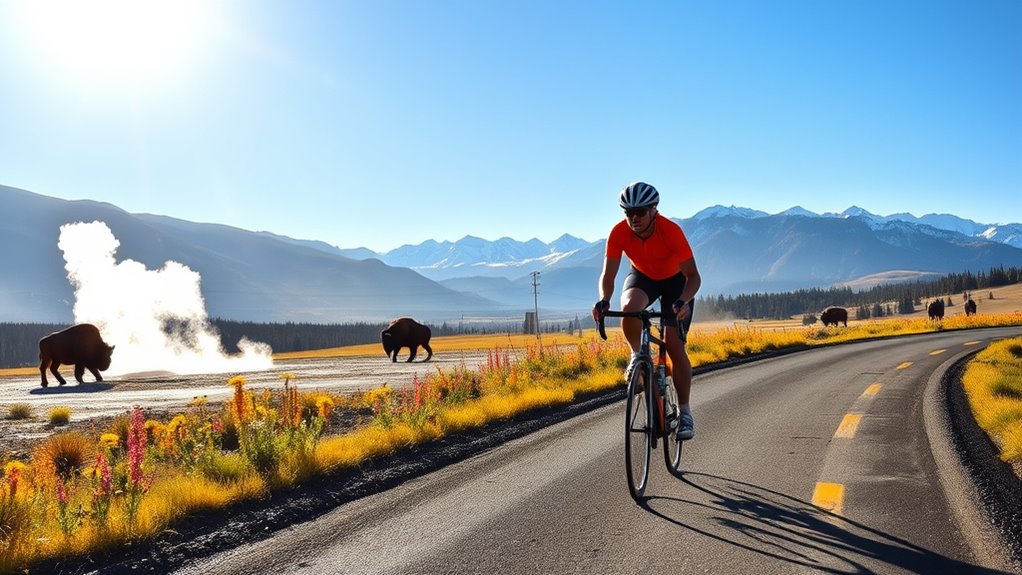
After purchasing your entrance fee and gearing up for your ride, you’ll want to be aware of the road conditions in Yellowstone.
You can enjoy 49 miles of routes from the West Entrance to Mammoth Hot Springs before the main roads open to cars.
Keep in mind that spring weather can be unpredictable, with snow and ice possible. Roads may have narrow shoulders and limited visibility, so always ride single file and yield to vehicles, including maintenance equipment.
Watch out for wildlife, as bears and bison often traverse these roads.
With limited restrooms and services, prepare for self-rescue and ensure you have a plan for emergencies.
Finally, check weather conditions frequently to stay safe on your adventure.
Recommended Safety Gear for Biking Adventures
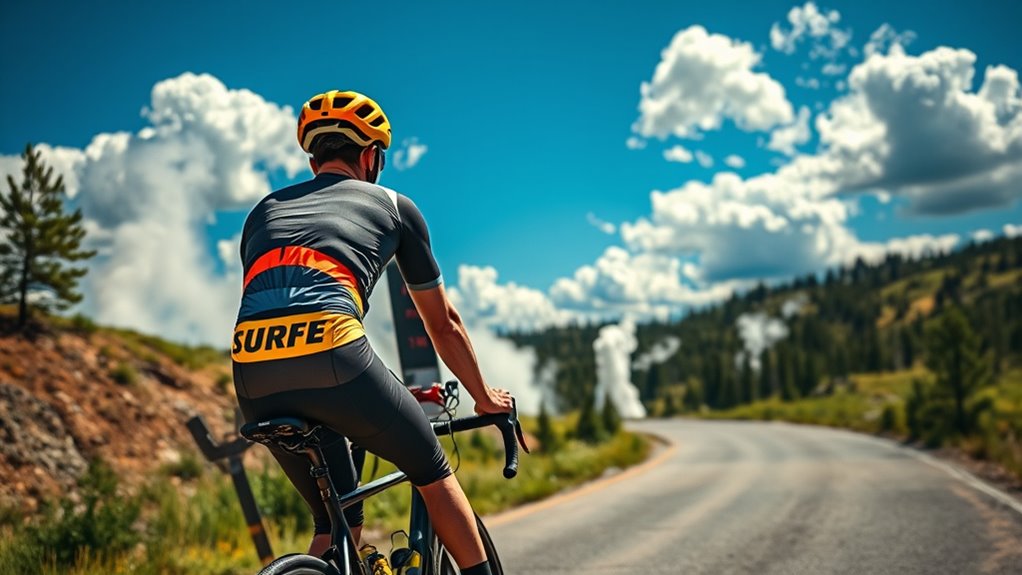
Five essential pieces of safety gear can make a significant difference during your biking adventures in Yellowstone.
First, always wear a properly fitting helmet to protect your head.
Always prioritize safety by wearing a properly fitting helmet to protect your head while biking.
Next, choose bright clothing to enhance your visibility among traffic and wildlife.
Carry bear spray to deal with unexpected encounters, and make sure you have a basic first aid kit for emergencies.
Lastly, equip your bike with front and rear lights, especially during dawn or dusk, to ensure you’re seen.
Additionally, maintaining a safe distance from wildlife is crucial to avoid potential dangers and ensure your safety while biking in high contrast ratios.
Remember to maintain a safe distance from wildlife, ride in single file, and follow all traffic rules.
Discovering Popular Bike Trails in the Park
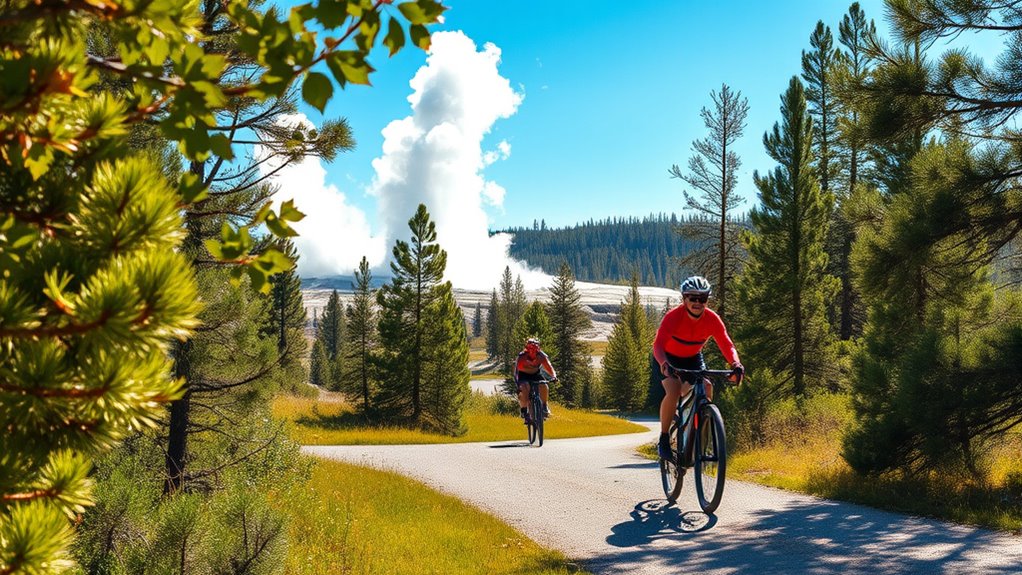
As you venture into Yellowstone, discovering the park’s popular bike trails can be an exhilarating experience that combines stunning landscapes with the thrill of outdoor adventure.
Start with the 2-mile round-trip from Old Faithful to Morning Glory Pool, passing iconic geysers. For a scenic challenge, bike to Lone Star Geyser on a 3.5-mile dirt road.
Mount Washburn’s trail rewards you with breathtaking views, but be prepared for some gear handling. If you’re near West Yellowstone, the Riverside Trail along the Madison River is perfect for wildlife spotting.
Finally, don’t miss the smooth Old Gardner Road Trail from Mammoth Hot Springs to the North Entrance. Each path offers unique sights that make your ride unforgettable.
Experiencing Yellowstone’s Iconic Geothermal Attractions
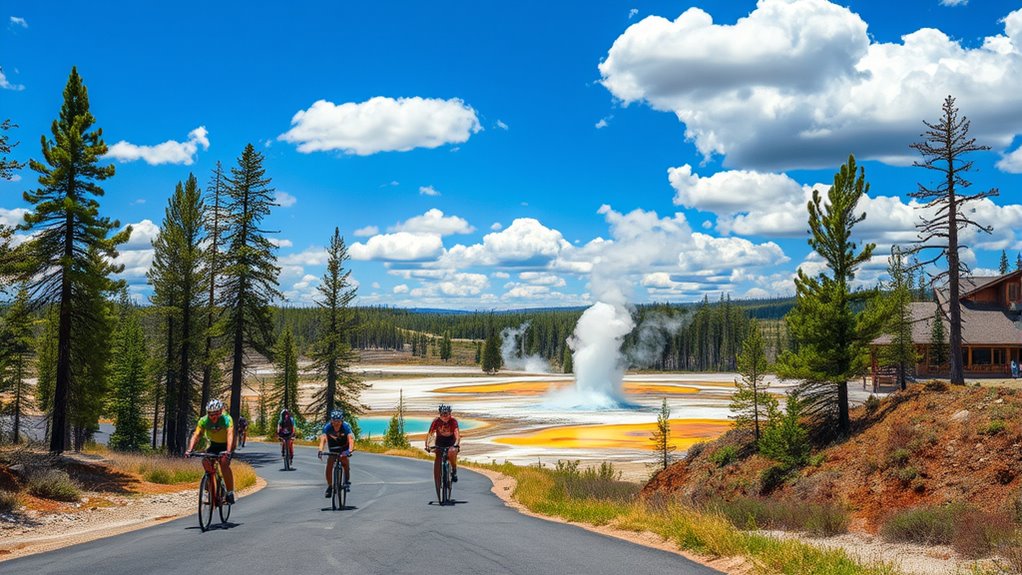
When you explore Yellowstone’s iconic geothermal attractions, you’ll encounter a mesmerizing array of natural wonders that showcase the park’s volcanic history.
Marvel at Old Faithful, known for its reliable eruptions that shoot water up to 180 feet high.
Marvel at the iconic Old Faithful, where powerful eruptions reach heights of up to 180 feet.
Don’t miss the Grand Prismatic Spring, the largest hot spring in the U.S., famous for its vibrant colors.
At Norris Geyser Basin, you’ll find one of the hottest thermal areas, while Mammoth Hot Springs features stunning travertine terraces.
As you pedal through, keep an eye out for the bubbling mudpots and hissing fumaroles.
Remember to stay on designated paths to protect these unique features and enjoy the dynamic beauty of this geothermal paradise safely.
Wildlife Viewing and Safety Precautions While Biking
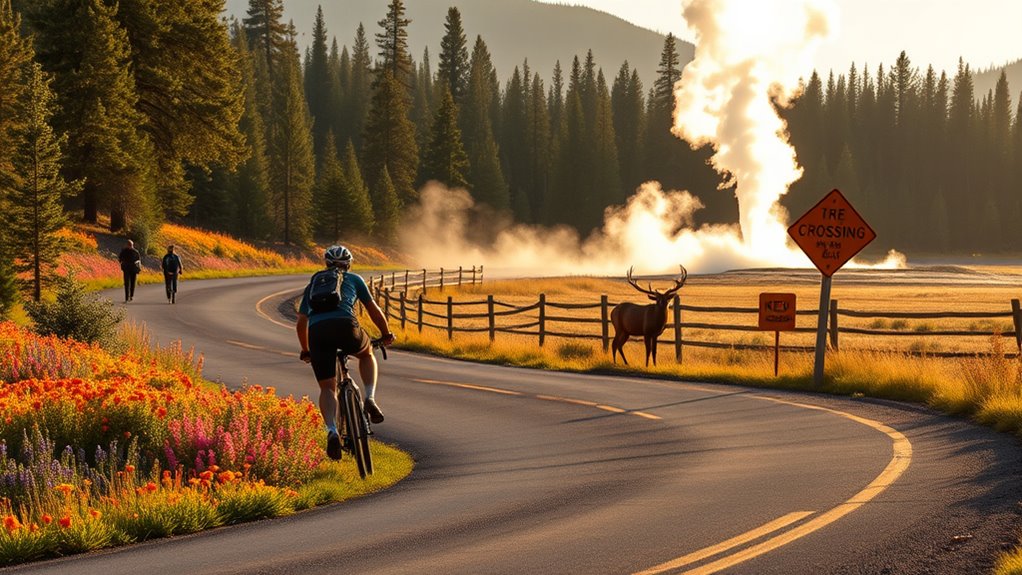
While biking through Yellowstone, you’ll likely encounter a variety of wildlife, making it essential to prioritize safety and respect for these magnificent animals.
Keep a safe distance—stay at least 100 yards away from bears and wolves, and 25 yards from other wildlife like bison and elk. Avoid startling them by never riding up behind them.
Carry bear spray in areas with bear activity, and ensure your bike has front and rear lights to enhance visibility. Be prepared for varying road conditions, and pack for self-rescue due to limited services.
Also, stay alert to traffic on the Grand Loop Road, and consider riding in groups for added safety. Always respect the wildlife and their space for a safe, enjoyable ride. Additionally, understanding the emotional volatility of wildlife can enhance your ability to safely navigate through their habitats.
Seasonal Considerations for the Best Biking Experience
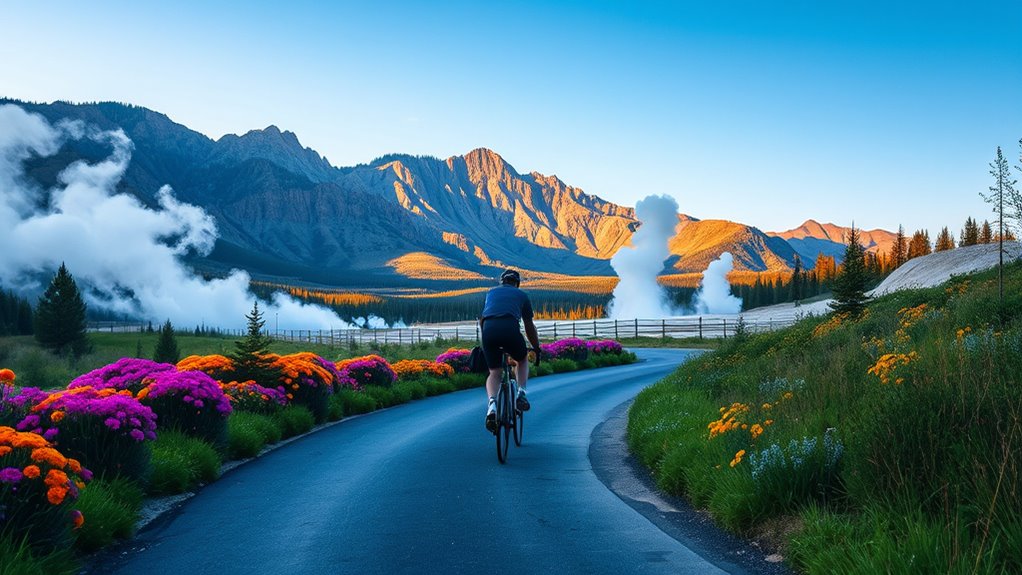
To make the most of your biking experience in Yellowstone, it’s crucial to consider the seasonal factors that can affect your ride.
Spring, from early April, welcomes cyclists after snow removal, but expect unpredictable weather and occasional weekend plowing delays.
Spring brings cyclists back to Yellowstone in early April, but be prepared for unpredictable weather and possible plowing delays.
Cycling in fall, especially in November when roads close to vehicles, offers a quieter experience. However, for the best conditions, plan your bike tour from late June onward when snow has melted.
Unique opportunities exist between April 2nd and 19th for riding from West Yellowstone to Mammoth Hot Springs.
Always stay on designated routes, pack layers, and check road conditions regularly to ensure a safe and enjoyable ride through this stunning landscape.
Frequently Asked Questions
Are There Restrooms Available Along the Bike Trails?
No, there aren’t dedicated restrooms along most bike trails in Yellowstone National Park.
You’ll mainly find restrooms at major hubs like visitor centers, picnic areas, and campgrounds. If you’re biking, it’s wise to plan your route to include stops at these locations.
For example, the Yellowstone Shortline Trail has a restroom near mile marker 8, but otherwise, you’ll need to rely on nearby facilities for restroom access during your ride.
Can I Bring My Own Bike to Yellowstone?
Imagine your bike as a trusty steed, ready to explore Yellowstone’s vast landscapes. Yes, you can bring your own bike to Yellowstone!
Just ensure it’s in good working condition to tackle the park’s roads. Mountain bikes, road bikes, and certain e-bikes are all welcome.
Remember to follow traffic rules, ride single file, and prepare for wildlife encounters. With the right preparation, you’ll enjoy an unforgettable ride through this stunning natural wonder.
What Is the Best Time to Bike for Wildlife Sightings?
The best time for you to bike for wildlife sightings in Yellowstone is during spring, particularly from late April to mid-June.
During this period, roads are closed to cars, allowing for a peaceful ride. Early mornings and evenings are prime times to spot wildlife as they’re most active then.
Be prepared for unpredictable weather and always keep a safe distance from animals, especially bears and bison, for your safety and theirs.
Are There Bike Repair Services Available in the Park?
You’ll find that bike repair services aren’t available within Yellowstone National Park itself.
Most bike shops are located outside the park, like Freeheel and Wheel in West Yellowstone.
It’s best to be self-sufficient, as services are limited, especially during early spring and late fall.
Make sure to carry your own tools and parts to handle any repairs.
Planning for this will ensure a smoother biking experience in the park.
Is There a Limit on Group Sizes for Biking?
When it comes to biking in Yellowstone, think of your group size like a gentle breeze—too many can create a storm. For guided tours, you’re limited to six people, including the guide.
However, if you’re biking independently, there’s no specific group size limit. Just remember to ride single file and keep safety at the forefront.
This way, you can enjoy the beauty of the park while adhering to its regulations!
Conclusion
In Yellowstone, biking blissfully blends breathtaking beauty with boundless adventure. You’ll savor stunning sights, from steaming geysers to majestic wildlife, while staying safe and smart. Ensure you gear up and glide through the park’s pristine paths, making memories that’ll last a lifetime. Remember, each pedal pushes you closer to nature’s wonders! So, grab your bike, embrace the experience, and let the spirit of Yellowstone sweep you away on this spectacular cycling journey!
